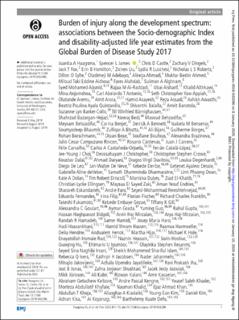| dc.contributor.author | Kisa, Adnan | |
| dc.contributor.author | Injury Collaborators, GBD 2016 | |
| dc.date.accessioned | 2022-10-20T12:00:11Z | |
| dc.date.available | 2022-10-20T12:00:11Z | |
| dc.date.created | 2020-02-16T15:15:41Z | |
| dc.date.issued | 2020 | |
| dc.identifier.citation | Injury Prevention. 2020, 26, i12-i26. | en_US |
| dc.identifier.issn | 1353-8047 | |
| dc.identifier.uri | https://hdl.handle.net/11250/3027316 | |
| dc.description.abstract | Background The epidemiological transition of non-communicable diseases replacing infectious diseases as the main contributors to disease burden has been well documented in global health literature. Less focus, however, has been given to the relationship between sociodemographic changes and injury. The aim of this study was to examine the association between disability-adjusted life years (DALYs) from injury for 195 countries and territories at different levels along the development spectrum between 1990 and 2017 based on the Global Burden of Disease (GBD) 2017 estimates. Methods Injury mortality was estimated using the GBD mortality database, corrections for garbage coding and CODEm—the cause of death ensemble modelling tool. Morbidity estimation was based on surveys and inpatient and outpatient data sets for 30 cause-of- injury with 47 nature-of- injury categories each. The Socio-demographic Index (SDI) is a composite indicator that includes lagged income per capita, average educational attainment over age 15 years and total fertility rate. Results For many causes of injury, age-standardised DALY rates declined with increasing SDI, although road injury, interpersonal violence and self-harm did not follow this pattern. Particularly for self-harm opposing patterns were observed in regions with similar SDI levels. For road injuries, this effect was less pronounced. Conclusions The overall global pattern is that of declining injury burden with increasing SDI. However, not all injuries follow this pattern, which suggests multiple underlying mechanisms influencing injury DALYs. There is a need for a detailed understanding of these patterns to help to inform national and global efforts to address injury-related health outcomes across the development spectrum. | en_US |
| dc.language.iso | eng | en_US |
| dc.relation.uri | https://injuryprevention.bmj.com/content/early/2020/01/08/injuryprev-2019-043296 | |
| dc.rights | Navngivelse 4.0 Internasjonal | * |
| dc.rights.uri | http://creativecommons.org/licenses/by/4.0/deed.no | * |
| dc.title | Burden of injury along the development spectrum: associations between the Socio-demographic Index and disability-adjusted life year estimates from the Global Burden of Disease Study 2017 | en_US |
| dc.type | Peer reviewed | en_US |
| dc.type | Journal article | en_US |
| dc.description.version | publishedVersion | en_US |
| dc.source.pagenumber | i12-i26. | en_US |
| dc.source.volume | 26 | en_US |
| dc.source.journal | Injury Prevention | en_US |
| dc.identifier.doi | 10.1136/injuryprev-2019-043296 | |
| dc.identifier.cristin | 1794477 | |
| cristin.unitcode | 1615,40,10,0 | |
| cristin.unitname | Institutt for helsevitenskap | |
| cristin.ispublished | true | |
| cristin.fulltext | original | |
| cristin.qualitycode | 1 | |

